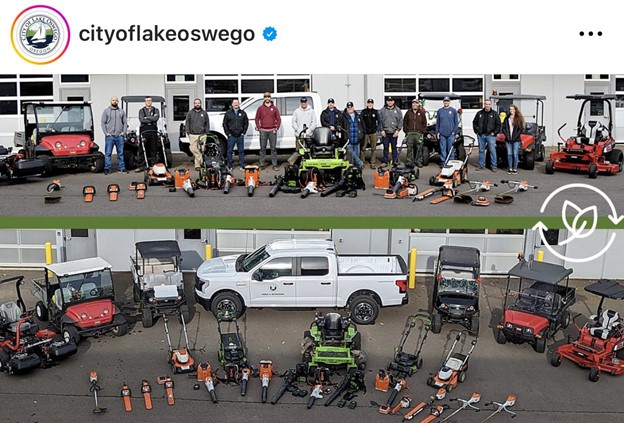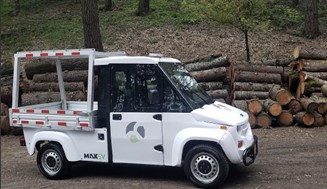Jul 24, 2025 | Education, Electrify LO, Electrify LO Journey, In-Person, Online
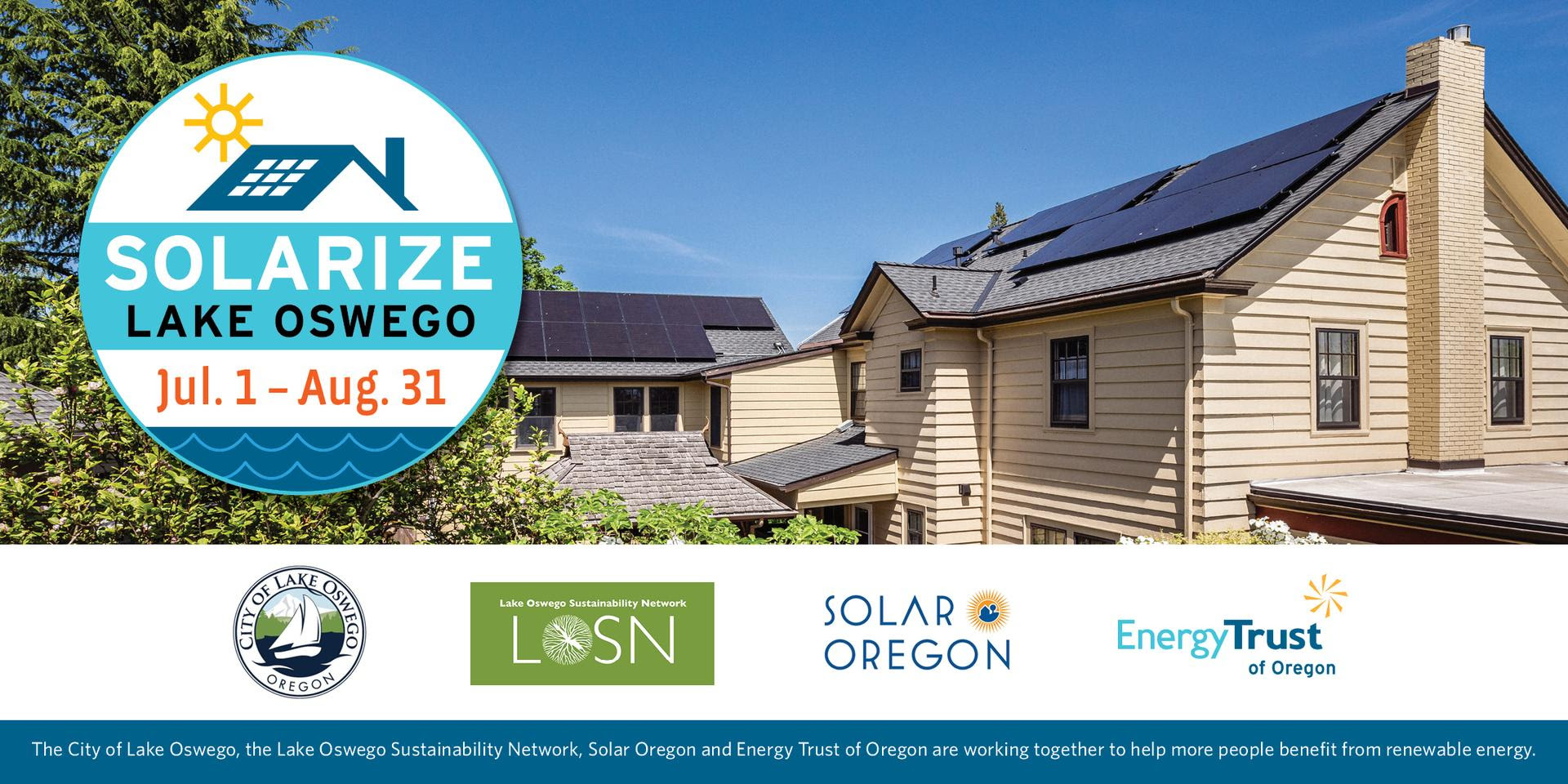
The roll back for federal support of clean energy signed into law in July 2025 included the end of the 30% tax credit for residential solar and home battery storage systems. If you want to obtain this Residential Clean Energy Credit you will need to have your residential solar and/or battery storage system installed and operational by December 31, 2025. Permits for solar systems take a couple of months to secure and many solar companies are reporting substantial demand. If you want to take advantage of this tax credit ACT NOW.
Get a bid from an Energy Trust of Oregon Allied Contractor through the ETO Solarize Lake Oswego webpage.
Get more information about solar at two free informational events in Lake Oswego.
|
|
|
Tuesday, July 29, 2025
12 – 1 pm
Online
|
|
Tuesday, August 19, 2025
6 – 7 pm
Lake Oswego Public Library
|
|
|
Why add solar to your home?
|
- You add clean energy to the grid.
- Oregon’s goal is to have investor-owned utilities reduce their greenhouse gas emissions by 80% by 2030. In 2024, PGE was only one third of the way to meeting that emission target. When Oregonians add solar they help meet this goal.
- You save money on your energy bills.
- The break-even point is reported between 8-14 years—after that you have paid off your system and your electricity is free. Residential solar systems usually last 25 years.
- Electricity prices continue to rise, so solar purchased now is a hedge against future electricity price increases.
- You add value to your home.
- A recent study showed residential solar increases the value of your home by an average of 6.9%.
- Homes with solar sell faster than those without solar.
- In Oregon, this increased value is exempt from property tax increase.
- If you add a battery system, you will be energy resilient.
- You will ensure that you have electricity during power outages.
|
|
|
Community Solar Works for Me – And Also Surprised Me
|
By Jim Newcomer, LOSN Volunteer
|
I’m a subscriber to community solar power, so I warn you that I’m writing with a bias: I love it. But wait, there’s more: I’m part of an experiment that could increase our nation’s vegetable supply. What?
First, here’s my experience with the program. About two years ago my wife and I, who rent our home, wanted to access electricity that was procured from clean, renewable sources that would produce few greenhouse gas emissions – that is, not from coal or natural gas. Since we could not erect solar panels on our landlord’s roof, we signed up for Community Solar Power through the Oregon Community Solar Project.
At first we were disappointed – all their available solar farms were fully subscribed, and we were put on a waiting list. After a couple of months, though, a new project opened near us, and they accepted us as a subscriber. Immediately we began to receive electricity from it…
|
|
|
Consult a coach from Electrify Oregon
|
|
|
Other federal tax incentives for clean energy for your home are going away soon. EV tax credits will expire on September 30. Home energy tax credits for heat pumps for heating and cooling your home and your hot water heater will end December 31, 2025. If you want to get some help figuring out how to bring clean energy into your home, find contractors, and get tax breaks and financial incentives, consider a free session with a coach from the nonprofit Electrify Oregon. LOSN is an allied organization of Electrify Oregon and several of the coaches live in Lake Oswego.
|
|
|
Jul 22, 2025 | Electrify LO, Electrify LO Journey
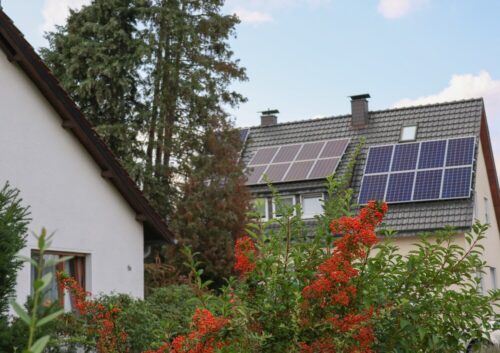
The roll back for federal support of clean energy signed into law in July 2025 included the end of the 30% tax credit for residential solar and home battery storage systems. If you want to obtain this Residential Clean Energy Credit you will need to have your residential solar and/or battery storage system installed and operational by December 31, 2025. Permits for solar systems take a couple of months to secure and many solar companies are reporting substantial demand. If you want to take advantage of this tax credit ACT NOW.
Get a bid from an Energy Trust of Oregon Allied Contractor through the ETO Solarize Lake Oswego webpage.
Why add solar to your home?
- You add clean energy to the grid.
- Oregon’s goal is to have investor-owned utilities reduce their greenhouse gas emissions by 80% by 2030. In 2024, PGE was only one third of the way to
meeting that emission target. When Oregonians add solar they help meet this goal.
- You save money on your energy bills.
- The break-even point is reported between 8-14 years—after that you have paid off your system and your electricity is free. Residential solar systems usually last 25 years.
- Electricity prices continue to rise, so solar purchased now is a hedge against future electricity price increases.
- You add value to your home.
- A recent study showed residential solar increases the value of your home by an average of 6.9%.
- Homes with solar sell faster than those without solar.
- In Oregon, this increased value is exempt from property tax increase.
- If you add a battery system, you will be energy resilient.
- You will ensure that you have electricity during power outages.
- Your house is a primary or secondary home, not a home you are renting.
- Your roof planes face south, east or west.
- Your roof does not have substantial shade.
- Obstruction by shade can be determined by satellite imagery.
- More refined analysis can be completed by your contractor.
- Your roof is in good condition and has at least 10 years of roof life.
What are the financial advantages of solar?
The federal tax credit is 30%.
- It is only valuable to homeowners who pay federal taxes.
- Make sure you have enough tax liability to take advantage of this tax credit.
- At this time, some tax liability can be carried forward to future years.
- Example: For a system that costs $30,000, the federal tax credit would be $9,000.
Energy Trust of Oregon offers additional rebates. These rebates will continue beyond the federal cut-off. For residents in Lake Oswego, they include:
Financing
- Financing of systems is common.
- Installers may offer financial plans.
- Credit unions may have loans tailored to solar.
- In the summer, during the day you will generate more electricity than you can use. This electricity will flow back into the grid. PGE will give you credit for this electricity.
- During the winter, when you are not generating enough electricity, PGE will supply you with electricity and you will pay the bill using the credits you’ve accrued from PGE in summer.
- This is called “net metering”.
- These credits roll over from month to month through the year, but not from year to year.
- If you have not used your credits by March 31, they are donated to low-income subscribers or nonprofits.
- When you purchase your system, your contractor will size your system based on your past use by looking at your PGE bills so that your net-metering credits fit your usage.
When you request a bid through the ETO Solarize Lake Oswego Website, installers will be clear with you if they can complete the work by December 31 so that you will be eligible for the 30% federal tax credit.
Jul 21, 2025 | Electrify LO, Electrify LO Journey, Natural Resources - Testimonials
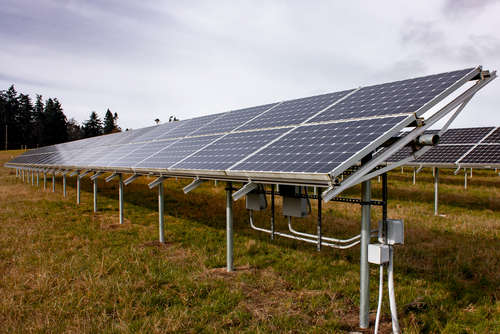
By Jim Newcomer, LOSN
I’m a subscriber to community solar power, so I warn you that I’m writing with a bias: I love it. But wait, there’s more: I’m part of an experiment that could increase our nation’s vegetable supply. What?
First, here’s my experience with the program. About two years ago my wife and I, who rent our home, wanted to access electricity that was procured from clean, renewable sources that would produce few greenhouse gas emissions – that is, not from coal or natural gas. Since we could not erect solar panels on our landlord’s roof, we signed up for Community Solar Power through the Oregon Community Solar Project.
At first we were disappointed – all their available solar farms were fully subscribed, and we were put on a waiting list. After a couple of months, though, a new project opened near us, and they accepted us as a subscriber. Immediately we began to receive electricity from it.
Nothing changed at our house. No new wires were connected; no adapters were required. We still got our power through those same PGE lines along our street, but PGE was receiving electrons from our solar farm and providing the equivalent flow of electrons to us from their power line. (Important concept – equivalent flow. It means we do not actually receive electrons from our solar farm into our home!)
We were informed that a company named Arcadia, a national firm that builds and manages solar farms in several states, had invested in our local solar farm and was managing our connection from there to PGE. We receive regular updates from them and we still, just as before, receive a monthly bill from PGE that oddly enough contains no mention of Arcadia or, for that matter, our connection to solar. We now receive normal electric service round the clock, of course, rain or shine, and we also experience all the power outages that occur to PGE customers. But I get a little rush of pleasure every time I think of our lights being powered by our solar farm!
I’ll add that in our experience the attraction of saving money on our monthly electric bill is virtually negligible – maybe $5 a month. Our satisfaction comes from knowing that despite renting our home, when we turn on the lights our energy comes directly from the sun instead of from a coal-fired generator or a natural gas turbine. We can say, just as if we had solar panels on our roof, most of our electricity is now clean and renewable.
Now here’s how we were surprised: Solar Harvest, the solar farm that produces our energy, is in a six-acre field not far from the airport in Aurora, down I-5 less than ten miles from our home. Then we discovered a second surprise: the Solar Harvest Farm near Aurora is operated by Oregon State University’s College of Agriculture as an experimental marriage of solar panels and farming.
There, under the rows of photovoltaic (PV) panels, they are planting shade-tolerant crops such as alfalfa, arugula, beets, bok choy, cabbage, carrots, chard, garlic, onions, parsley, radish, spinach, sweet potato, turnips and yams. To make it work, they have even enabled some of the solar panels to tilt up to allow tractors to pass.
Their purpose? To see if growing things under and among solar panels would increase production by cooling the ground in hot summer months and saving water. And it does! In their report evaluating the results from these last few summers, the authors come as close to waxing ecstatic as academic authors are allowed:
“Lettuce alone could justify a national project in agrivoltaics,” they report. “In 2012, U.S. farmers grew lettuce on 267,100 acres. PV panels on that land could generate 77 GW of electricity, more than the total U.S. installed capacity (60 GW) of PV power in 2018. Research by Prof. Chad Higgins, Solar Harvest Principal Investigator, shows that converting just 1% of the world’s agricultural land to agrivoltaics would offset global energy demand.”
Even more surprising, they have discovered an echo effect that boosts the benefits in the other direction as well: growing crops under PV panels cools the panels in return and thereby actually increases the efficiency of their solar production by some ten percent. It works both ways: PV panels increase vegetable production, and vegetable production increases electrical generation from the PV panels.
Just by signing up for free, in fact, saving $5 per month on our electricity bill, we get to be part of a grand, successful scientific experiment that will benefit people all over the world as well as slow climate change. What’s not to like?
As an obvious next step, Columbia Insight reported in 2023 that the OSU Extension Service is spreading this new idea among Oregon farmers: they don’t have to give up growing crops if they accept a solar farm on their land. In fact, they might even increase their yields in the fields when they erect photo-voltaic panels. The implications of that for agriculture are stunning.
All that information and satisfaction sprung from my family’s easy buy-in to a piece of a community solar project.
For more information, Electrify Now features short videos on its website about the advantages of signing up with community solar. And you can sign up there to connect. For even more detailed information, Electrify Now sponsored a free 45-minute webinar entitled “Community Solar – the Best-Kept Secret in Renewable Energy,” on July 17 featuring leaders of several of these community solar power organizations in a discussion of the state of community solar power today. The webinar recording is available here.
When you are ready you can join too, through any of these gateways: Oregon Clean Power Cooperative, Common Energy, or Electrify Now.
Nov 1, 2024 | Community, Community
As one of the few environmental groups in Lake Oswego, we take our responsibility seriously. We feel compelled to do as much as we can to promote a safe future, and advocacy can make a big difference.
Public policy can accomplish some things that individual actions cannot.
- It can support individual action by removing barriers to positive actions. For example, think about the public policy that allows people to sell excess solar to the grid.
- It can accomplish environmental goals faster. Think about the Clean Air Act, which dramatically reduced pollution by requiring filters in cars and factory smoke stacks.
|
|
What is LOSN Advocacy?
At LOSN, we have an advocacy team whose purpose is to review, initiate and promote new policies that build sustainability in Lake Oswego. Here are some of our activities:
- We review and support what others are doing at the state level. What are the environmental groups or local organizations supporting? We can add our voice.
- We initiate and promote ideas for Lake Oswego. LOSN has introduced a number of new concepts to Lake Oswego. For example, LOSN was the original supporter of the city’s climate action plan. We had heard of other cities that were adopting these plans and we thought LOSN should have one – so we promoted it.
- We follow a rigorous vetting process within LOSN. A new policy proposal must run quite the gamut before we decide to support it. Each idea is vetted through our advocacy team – sometimes that takes multiple discussions. We often consult and work with other LOSN committees. Before we make our final decision, we get a consensus yes vote from our entire board.
- We have an advocacy policy to ensure that our internal conversations and community outreach are respectful and productive.
- We have partners. There is strength in connection, and we work closely with Respond to Racism, Oswego Lake Watershed Council, MCAT (Mobilizing Climate Action Together, a subgroup of the Oregon League of Conservation Voters and others.
- We create campaigns to support our favored policies. We mobilize individuals to support, organize letter writing campaigns and talk to local policy makers.
|
|
Here are some of the important issues we have worked on:
- Protecting the city Sustainability Advisory Board and program against budget cuts (in place)
- A climate action plan for the city (in place)
- Electric school buses for the Lake Oswego School District (story below)
- Affordable housing in Lake Oswego (housing will be ready for occupancy soon)
- Exploring ways to phase out gas-powered leaf blowers (ongoing)
- Review of new facilities: the wastewater treatment plan and the recreation center
- State incentives for heat pumps, energy efficiency and electric vehicles (many of these are in place)
- State laws regarding waste management (new laws are in place)
- Improving state climate goals (defeated last year – up again at the state legislature)
- The state climate protection plan (ongoing)
|
|
What are we working on now?
- Affordable housing policies for Lake Oswego
- Phase out gas-powered leaf blowers in Lake Oswego
- Testifying in favor of state issues.
How can you get involved?
- We are always looking for new committee members
- We are exploring the idea of providing local advocacy training
|
|
| Contact Us to Get Involved |
|
Electric school buses are coming!
For five years, LOSN has been advocating for electric school buses in our community. Now four will arrive this coming year thanks to a PGE grant awarded to the Lake Oswego School District (LOSD).
Read more about the electric school buses coming to Lake Oswego.
In the coming years, LOSD may evaluate how and when to transition the entire bus fleet to electric. In the meantime, LOSN will continue to promote electric school buses as a healthy, sustainable choice.
|
|
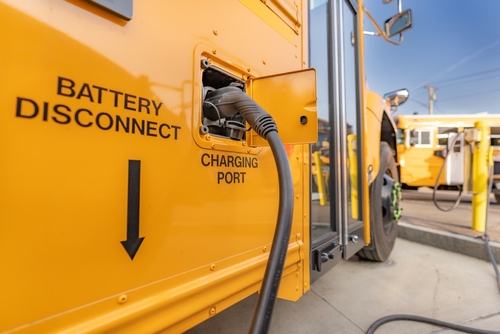 |
Lake Oswego School District: An Electric School Bus Case Study
We have found that impacting policy and making big changes takes a combination of time, often years, and creative problem solving. Sometimes people in leadership aren’t interested in our ideas, and we need to be persuasive. Sometimes we are engaged with public opposition or confusion.
Electric school buses provide an example of an issue we worked on that took time, engagement and persuasion. In this case, the people in leadership were very open to the idea of electric school buses because they are quieter, cleaner and healthier for students, and better for the environment. All the major work was done by the Lake Oswego School District (LOSD), and the credit belongs to them, but LOSN worked to create interest in the issue, supported the school board’s efforts and did public outreach.
In 2019, LOSN board member Duke Castle, heard that some school districts in the US were starting to use electric school buses. Duke has been promoting electric vehicles for years in Lake Oswego and was excited about the prospect of getting electric school buses in Lake Oswego. He contacted LOSD board member John Wallin, who expressed interest.
At that time, electric buses were 3 to 4 times more expensive than diesel and would require greater electric capacity for charging than was available at the former Lake Grove bus barn location. The district had acquired land in the Lakeview industrial park that would meet their needs for a bus barn. Duke spoke with Tony Vandenberg, LOSD Executive Director of Project Management, who was in charge of developing the new facility.
Duke researched and found that private companies like Highland Electric offered financing for electric school buses. A representative from that company told LOSD that their new location would be a good site for electric school buses.
Some of the neighbors near the proposed new site of the bus barn were concerned about noise and added pollution, so the LO Planning Commission did not approve the new location in 2019. The issue was tabled as the school district searched for a different location. By 2023, the district realized that the location they’d found in the Lakeview industrial park was the only one that suited their needs and went back to the Planning Commission.
After more research and discussion, and weighing the pros and cons, the LOSD board unanimously agreed to move forward. That’s when LOSN’s advocacy team got involved. Recognizing this location for the bus barn provided the only path forward for electric buses, we sent an action alert to our mailing list asking for comments to support electric school buses. Many comments were sent to the Planning Commission. In the end, the Planning Commission and City Council concurred with the school district. Almost five years after this project began, the bus barn is now operating in the new location.
|
|
|
|
Hear from the Electrification Experts
|
|
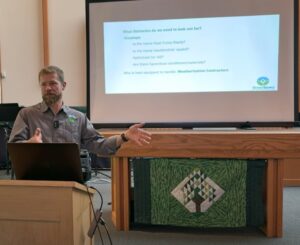 |
LOSN welcomed several experts in home and vehicle electrification to speak at our event this past September. To view a recording of their presentations, visit our YouTube channel.
|
|
|
|
|
|
|
|
|
|
|
|
|
|
|
|
|
|




